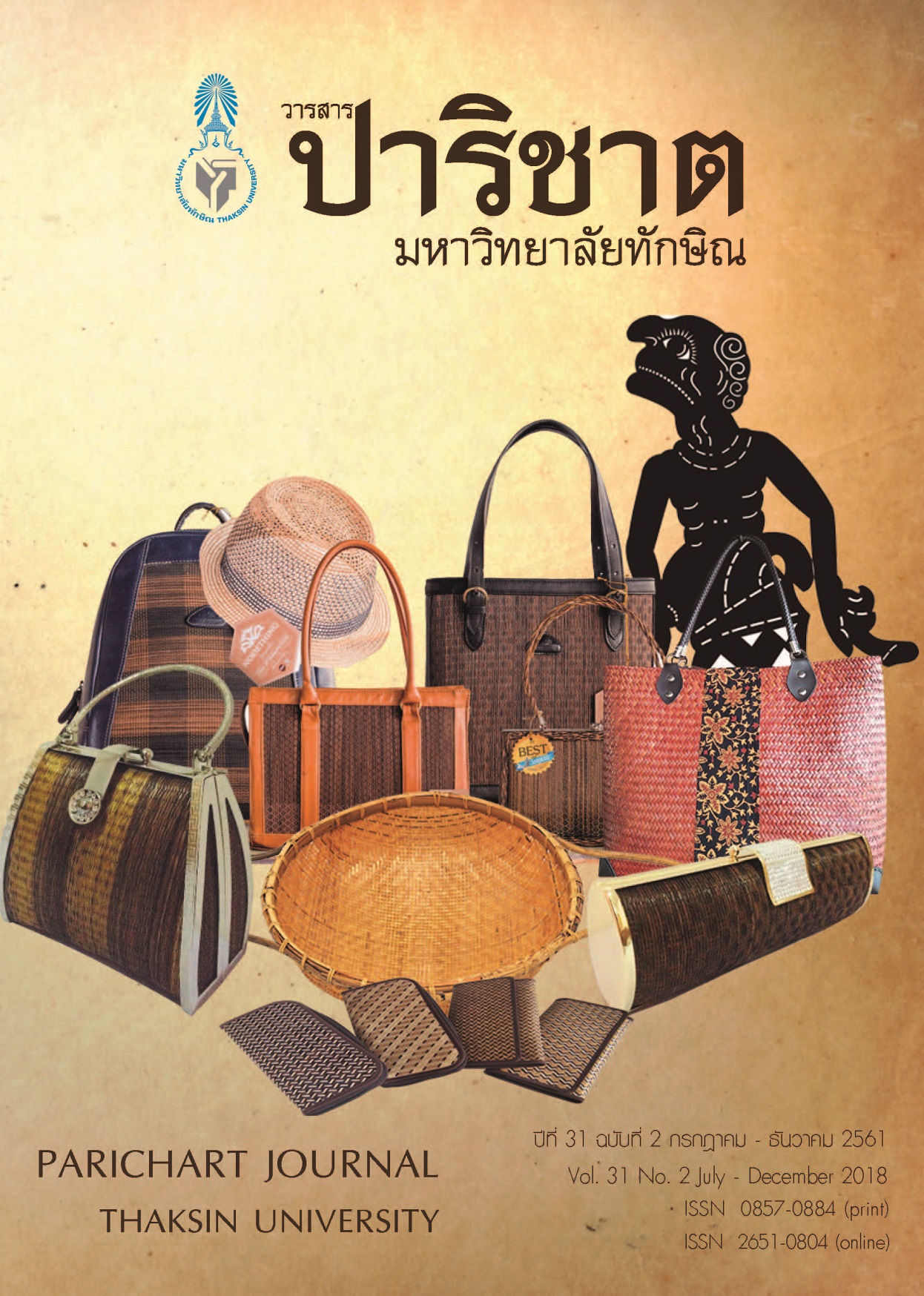Relativization Strategies of 2 to 5-year-old Thai Children
Main Article Content
Abstract
This paper aims to explore 1) the relativization strategies and
2) positions of relativized gaps, pronouns, and noun phrases in relative
clauses of 2 to 5-year-old Thai children. Cross-sectional data were collected
from 80 children, who were 2-5 years old speaking standard central Thai
as their native language. The results reveal 3 relativization strategies i.e.
gap strategy by 68.94 percent, pronoun strategy by 25.53 percent, and
non-reduction strategy by 5.53 percent. The relativization with gaps,
resumptive pronouns, and full noun phrases are found in 2 positions of
relative clauses: subject position by 77.02 percent, and direct object
position by 22.98 percent.
Article Details
How to Cite
Pindabaedya, P., & Indrambarya, K. (2018). Relativization Strategies of 2 to 5-year-old Thai Children. Parichart Journal, 31(2), 37–58. retrieved from https://so05.tci-thaijo.org/index.php/parichartjournal/article/view/158641
Section
Research Articles
References
[1] Comrie, B. and Kuteva, T. (2013). Relativization on Subjects. Leipzig: Max Planck Institute for Evolutionary Anthropology. Retrieved March 28, 2015, from http://wals/chapter/122.
[2] Keenan, E. and Comrie, B. (1977). “Noun Phrase Accessibility and Universal Grammar”, Linguistic Inquiry. 8, 63-99.
[3] Andrew, A.D. (2007). “Relative Clauses”, In Timothy Shopen (Editor). Language Typology and Syntactic Description Volume II: Complex Constructions. 206-236. United Kingdom: Cambridge University Press.
[4] ปราณี กุลละวณิชย์. (2553). “อนุประโยคขยายนาม: คุณานุประโยคและอนุประโยคเติมเต็มนาม”, ใน อมรา ประสิทธิ์รัฐสินธุ์ (บรรณาธิการ). หน่วยสร้างที่มีข้อขัดแย้งในไวยากรณ์ไทย. 7-65. กรุงเทพฯ: โรงพิมพ์แห่งจุฬาลงกรณ์มหาวิทยาลัย.
[5] กิติมา อินทรัมพรรย์. (2554). “คุณานุประโยคและอนุประโยคเติมเต็ม”, ใน อมราประสิทธิ์รัฐสินธุ์ กิติมา อินทรัมพรรย์ และนัฐวุฒิ ไชยเจริญ. รายงานวิจัยฉบับสมบูรณ์โครงการไวยากรณ์ไทยฉบับครอบคลุมภาษาย่อย เล่มที่ 1 เรื่อง ไวยากรณ์ภาษาไทยมาตรฐาน. 261-285.
[6] Eisenbeiss, S. (1984). “Production methods in language acquisition research”, In Elma Blom and Sharon Unsworth (Editors). Experimental Methods in Language Acquisition Research. 27, 11-34. Amsterdam: Tohn Benjamins Publishing Company.
[7] Ambridge, B. and Rowland, C.F. (2013). “Experimental Methods in Studying Child Language Acquisition”, WIREs Cogn Sci. 4(2), 124-168.
[8] O’Grady, W. (2011). “Relative Clauses: Processing and Acquisition”, In Evan Kidd (Editor). The Acquisition of Relative Clauses: Processing, Typology and Function. USA: John Benjamins Publishing Company.
[9] Yaowapat, N. and Prasithrathsint, A. (2007) . “A Typology of Relative Clauses in Mainland Southeast Asian languages”, Mon-Khmer Studies. 38, 1-12.
[10] Diessel, H. (2004). The Acquisition of Complex Sentences.Cambridge: Cambridge University Press.
[11] Brant, S., Diessel, H. and Tomasello, M. (2008). “The Acquisition of German Relative Clauses: A Case Study”, Journal of Child Language. 35(2), 325-348.
[12] Diessel, H. (2009). The Emergence of Relative Clauses in Early Child Language. University of Jena.
[13] Traxler, J. M., Williams, R.S., Blozis, S.A. and Morris, R.K. (2005). “Working Memory, Animacy and Verb Class in the Processing of Relative Clauses”, Journal of Memory and Language. 53, 204-224.
[14] Yaowapat, N. (2005). “Pronoun Retention in Khmer and Thai Relative Clauses”, SEALS XV: Paper from the 15th Meeting of the Southeast Asian Linguistics Society. 121-132.
[15] Diessel, H. and Tomasello, M. (2000). “The Development of Relative Clauses in Spontaneous Child Speech”, Cognitive Linguistics. 11, 131-151.
[2] Keenan, E. and Comrie, B. (1977). “Noun Phrase Accessibility and Universal Grammar”, Linguistic Inquiry. 8, 63-99.
[3] Andrew, A.D. (2007). “Relative Clauses”, In Timothy Shopen (Editor). Language Typology and Syntactic Description Volume II: Complex Constructions. 206-236. United Kingdom: Cambridge University Press.
[4] ปราณี กุลละวณิชย์. (2553). “อนุประโยคขยายนาม: คุณานุประโยคและอนุประโยคเติมเต็มนาม”, ใน อมรา ประสิทธิ์รัฐสินธุ์ (บรรณาธิการ). หน่วยสร้างที่มีข้อขัดแย้งในไวยากรณ์ไทย. 7-65. กรุงเทพฯ: โรงพิมพ์แห่งจุฬาลงกรณ์มหาวิทยาลัย.
[5] กิติมา อินทรัมพรรย์. (2554). “คุณานุประโยคและอนุประโยคเติมเต็ม”, ใน อมราประสิทธิ์รัฐสินธุ์ กิติมา อินทรัมพรรย์ และนัฐวุฒิ ไชยเจริญ. รายงานวิจัยฉบับสมบูรณ์โครงการไวยากรณ์ไทยฉบับครอบคลุมภาษาย่อย เล่มที่ 1 เรื่อง ไวยากรณ์ภาษาไทยมาตรฐาน. 261-285.
[6] Eisenbeiss, S. (1984). “Production methods in language acquisition research”, In Elma Blom and Sharon Unsworth (Editors). Experimental Methods in Language Acquisition Research. 27, 11-34. Amsterdam: Tohn Benjamins Publishing Company.
[7] Ambridge, B. and Rowland, C.F. (2013). “Experimental Methods in Studying Child Language Acquisition”, WIREs Cogn Sci. 4(2), 124-168.
[8] O’Grady, W. (2011). “Relative Clauses: Processing and Acquisition”, In Evan Kidd (Editor). The Acquisition of Relative Clauses: Processing, Typology and Function. USA: John Benjamins Publishing Company.
[9] Yaowapat, N. and Prasithrathsint, A. (2007) . “A Typology of Relative Clauses in Mainland Southeast Asian languages”, Mon-Khmer Studies. 38, 1-12.
[10] Diessel, H. (2004). The Acquisition of Complex Sentences.Cambridge: Cambridge University Press.
[11] Brant, S., Diessel, H. and Tomasello, M. (2008). “The Acquisition of German Relative Clauses: A Case Study”, Journal of Child Language. 35(2), 325-348.
[12] Diessel, H. (2009). The Emergence of Relative Clauses in Early Child Language. University of Jena.
[13] Traxler, J. M., Williams, R.S., Blozis, S.A. and Morris, R.K. (2005). “Working Memory, Animacy and Verb Class in the Processing of Relative Clauses”, Journal of Memory and Language. 53, 204-224.
[14] Yaowapat, N. (2005). “Pronoun Retention in Khmer and Thai Relative Clauses”, SEALS XV: Paper from the 15th Meeting of the Southeast Asian Linguistics Society. 121-132.
[15] Diessel, H. and Tomasello, M. (2000). “The Development of Relative Clauses in Spontaneous Child Speech”, Cognitive Linguistics. 11, 131-151.


